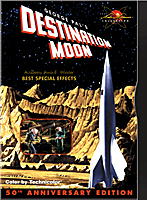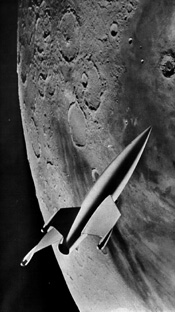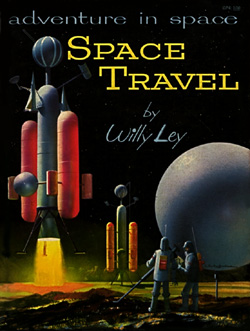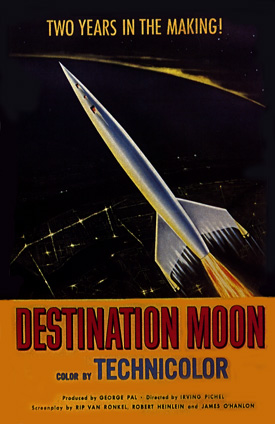| Release List | Reviews | Price Search | Shop | Newsletter | Forum | DVD Giveaways | Blu-Ray/ HD DVD | Advertise |
| Reviews & Columns |
|
Reviews DVD TV on DVD Blu-ray International DVDs Theatrical Reviews by Studio Video Games Features Collector Series DVDs Easter Egg Database Interviews DVD Talk TV DVD Talk Radio Feature Articles Columns Anime Talk DVD Savant HD Talk Horror DVDs Silent DVD
|
DVD Talk Forum |
|
|
| Resources |
|
DVD Price Search Customer Service #'s RCE Info Links |
|
Columns
|
 |
Destination Moon
Destination Moon Image Entertainment 1950 / Color / 1:37 flat full frame / Dolby Digital mono English / Street Date: February 29, 2000 Starring John Archer, Warner Anderson, Tom Powers, Dick Wesson, Erin O'Brien Moore Cinematographer Lionel Lindon Production designer Ernst Fegté Technical advisor of astronomical art Chesley Bonestell Music Leith Stevens Directed by Irving Pichel Written by Alford 'Rip' Van Ronkel and Robert A. Heinlein Produced by George Pal
Image brings out the very first serious interplanetary Space movie on DVD, just in time for the theatrical release of Mission to Mars. This review is also an essay about the issues raised by Destination Moon, and their relationship to the 50s Science Fiction films that followed it. In 1949 an inspired team of independent Hollywood creatives finally got their break to make Destination Moon, which holds the honor of being the very first film of the 1950's science fiction craze. It seems that studio reluctance kept this new genre from getting its start earlier - in the late 40's Flash Gordon and Buck Rogers were cheapo serial fodder and real science fiction like Things to Come and Metropolis were largely forgotten boxoffice flops. Hi-tech awareness had yet to grip the culture. Written Sci Fi was for goggle-eyed boys, the (now overemphasized) flying saucer cult wasn't considered anything to base a movie on ... and face it, Hollywood just wasn't yet hip enough to see the incredible movie potential in outer space. Moon's pedigree is pretty darn high. Robert Heinlein (now well known again through Starship Troopers) and Alford 'Rip' Von Ronkel adapted Heinlein's book Rocketship Galileo and shopped around for years until the beloved George Pal, fresh from a lacklustre first feature about a magical squirrel, got the project greenlighted at Eagle-Lion. With the socko artwork of Chesley Bonestell (perhaps the real star of the film) showing up in scads of national magazines, Destination Moon had a solid media push early in 1950. The new genre launched by Moon started even before it reached movie screens: Lippert's Rocketship X-M was rushed into production and actually came out a month before Pal's color extravaganza.
When their latest V-2 rocket test fails and government funding collapses, rocket scientist Dr. Charles Cargraves (Warner Anderson) and space enthusiast General Thayer (Tom Powers) enlist the aid of aircraft magnate Jim Barnes (John Archer). With the necessary millions raised from a group of adventurous and patriotic industrialists they build a ship at a desert base, but the project is threatened by a public uproar over radiation safety. The three idealists circumvent legal efforts to stop their project by launching ahead of schedule with a substitute radio operator, Joe Sweeney (Dick Wesson). In space, they almost lose a crewman when they go outside the ship to free a frozen radio antenna. Barnes's landing uses up too much fuel, and after exploring the surface they discover that they must lighten ship if their remaining fuel is to get them home. No matter how much equipment they throw overboard, it looks as though someone will have to stay behind if the other three are to return to the Earth ... In 1950 the thrilling novelty Destination Moon introduced the world to the concept that space travel was a real possibility. The prevailing cultural image of the moon said it was made out of "green cheese." Actually going there was the province of Baron Munchausen, and visionaries who lobbied for such ideas attracted the level of respect afforded common loonies. Only after the atomic bomb did Big Science start to command attention on Wall Street and in Washington. George Pal wisely countered this Lunar unfamiliarity by including a Woody Woodpecker cartoon sequence to spell out the basics of space travel in a way any yahoo could understand (well, at least the yahoo industrialists watching it seem to). The most criticized aspect of the film now is the inclusion of comic Dick Wesson as an audience surrogate, to whom the wonders and puzzles of space travel like weightlessness and the vacuum of space can be patiently and condescendingly explained. The Walt Disney attitude toward educating the public on technology would seem to have gotten its start here: "Welcome to the wonderful world of our electric future ... watch the cute cartoon character do silly things YOU would never do ... don't try to understand any of this, that's OUR job ... just keep consuming, folks, and we'll do the thinking." 
Destination Moon is groundbreaking, hardcore Science Fiction. There's hardly anything fanciful about it at all - even 2001, with its aliens and mystical hoo-haw, is not as pure. Fritz Lang/Thea von Harbou's Woman in the Moon (1929) may have invented the countdown 1 but their rocket (theorized by later real Nazi rocket scientists) took off from a pool of water and had all the beauty of a cannon shell. Destination Moon's spaceship Luna is a dazzler which set the style for space vehicles. 2 Featureless, dart-shaped chromium rockets would dominate the screen for years, until authentic space hardware became commonplace. When the real Apollo moon landing came in 1969 the parallels to Destination Moon were eerie. Not only were the basic flight mechanics similar but, just as in the movie, Neil Armstrong's descent to the moon's surface required a last-second sideways maneuver to find an appropriate landing site. The Luna voyagers also formally claim the moon in a speech not unlike Armstrong's, dedicating Earth's lifeless satellite to all the people of the Earth. Soon after the space program got rolling, Lyndon Johnson moved NASA headquarters to his home state of Texas; in Destination Moon one of the moneybags who bankrolls the moon shot is a drawling Texan who jokes that they'll have to build the rocket in the Lone Star State becasue it's the only one big enough to hold it. Space science addicts who welcomed the realism of Destination Moon did not automatically endorse the ensuing wave of Hollywood Science Fiction. Ten or so A-pictures would follow, but all dropped the semidocumentary approach to better concentrate on horror, adventure and other fantastic thrills. George Pal's own followup, the big Paramount production When Worlds Collide was reviled in technical articles that ridiculed its lack of basic scientific values. Destination Moon had done the work of punching through the "science barrier," and judging by what audiences wanted to see thereafter, scientific verisimilitude was just an excuse to get to the good stuff - invading aliens, ray guns, mayhem and disaster. Five years later, when George Pal tried to return to the pure docudrama with Conquest of Space, the show was capsized by buffonish comic relief and ridiculous melodrama. 3 
The Genesis of Cold War Science Fiction. Destination Moon should be shown in every American History class, as it argues convincingly that the 50's space race was a military project disguised for the American public as a noble scientific quest. Science fiction authors criticized the genre for polluting good literary science fiction with puerile monsters and psuedo-science, but what stands out now in these films are their unpleasant cold-war messages. For example, The Thing from Another World indicts its 'deluded' Dr. Carrington's scientific zeal as both un-humanitarian and defeatist, against the alien (Communist?) threat. The giant ants of Them! are a pure menace that must be ruthlessly eradicated, dwarfing petty considerations like human rights and the law. But Destination Moon's jingoism is far more direct ... its politics come more from I Married a Communist than Woman in the Moon. When Dr Cargave's rocket blows up, all involved assume that unseen Communist sabotage is responsible, and we are meant to agree. The moon project is a no-go until its promoters play the "Red Card" - sermonizing that whoever reaches the moon first will militarily control the Earth (a sentiment echoed eerily in Invaders from Mars). Only then do the industrial millionaires fall obediently in line, doing "what the government can't do" - i.e., fund necessary military-space projects. The bold implication is that Commie Pinkos in Washington are trying to cripple America's defense ... at a time when Military expenditures were actually growing exponentially every year. Finally, when the Howard Hughes-like Barnes sees headlines in the paper warning of radiation danger from their atomic rocket testing, he proclaims the dissent to be direct, paid Communist propaganda orchestrated for the express purpose of hurting America. The headlines spur the project to do what all right-wing government efforts end up doing, namely, lie to the public, become ultra-secretive and break the law. Destination Moon isn't watched that much anymore, but when it is shown audible gasps come from the audience when these moments happen ... the first American moon shot is made by zealots who thumb their nose at a court order to delay their launch, just because of a little possibility like poisoning the Earth with a reactor-load of plutonium.
Moon's news reports crying about a radiation threat are characterized as Communist propaganda, which is either an incredible coincidence or evidence of producers voluntarily tailoring their films to mirror government policy. 1949's D.O.A. is a movie about radiation poisoning, yet euphemistically buries the entire issue by renaming the malady that kills Edmond O'Brien as "luminous poisoning." Ivan Tors' GOG exposes a scientist to a massive dose of radiation while battling killer robots. At the end she lies smiling in her hospital bed and is told that in a few days she'll be as right as rain. 4 These were the years of secret government experiments exposing soldiers and civilians unknowingly to radioactive elements. Savant doesn't believe that Science Fiction movies of the time portrayed radiation as harmless to people as a planned coverup. Hollywood was most likely patriotically parroting the Atomic Energy Commission's 'safe nuke' public relations because they believed it with the rest of us. Radiation in Science Fiction became a completely fantastic, all-purpose Genie in a Bottle that made ants grow and people shrink. Not until 1959's On The Beach did the notion resurface that radiation was a bad thing that could do really nasty stuff. Like, you know, depopulate the Earth.
There was a three-part animated Disney television special from 1955 called Disney in Space and Beyond. It was a Sunday night show that introduced the concept of space travel through cartoons, just as George Pal had shown Woody Woodpecker playing with a shotgun. The first two parts were so much like a sales film for the space program that I'm sure the whole enterprise was an intentional public relations campaign to get NASA funding. The third episode Mars and Beyond was more speculative. I can remember the chilling feeling in the comic book version when the Mars spacemen (they weren't called astronauts yet) saw a shapeless amoeba-like cloud appear from behind a hill or something. Like many another Disney propaganda film - the wartime Victory Through Air Power for example - it was rarely shown again. (Note 5/13/04: They've all been released as Disney Treasures DVDs, see review links above) Image's New DVD. 
Image Entertainment's new DVD of Destination Moon is a good opportunity to finally see this milestone film in something resembling its original form. It has circulated for years in fuzzy 16mm prints and worse television versions. Here the Technicolor is bright and the picture sharp. This reveals the underpinnings of the Oscar-winning special effects, what with wires now visible holding up floating astronauts and spaceships, but it also shows the beautiful detail in Chesley Bonestell's paintings. If this was mastered from a Technicolor print original, the transfer is particularly good; nice details are coaxed from the darker areas of the frame. The Image / Corinth / Wade Williams print is not perfect, but it is the best Savant has seen. There is some film wear, amounting to a few splices and intermittent white speckling, but it is a sharp 35mm source, very stable onscreen. The audio cleanup is particularly good. DVDs with visual dings usually display a soundstorm of pops, scratching noises and crackles, but Moon's mono track is perfectly clear. Destination Moon was one of Eagle-Lion's most successful releases. But when that company's Arthur Krim bought United Artists and folded his old banner, few titles in the Eagle-Lion library came to UA. Moon was never released to home video by MGM because, through some undisclosed chain of events, collector / distributor Wade Williams renewed the copyright in 1978. Unlike some of his other holdings, Destination Moon is refreshingly intact. The only extra is an arresting trailer that pushes fun copy text like, "JOIN A WEIRD TRIP OF LUNAR EXPLORATION!" It also hawks Moon as a show with femme appeal: "NEVER BEFORE HAS ANY WOMAN SENT HER MAN ON SUCH AN EXPLOIT!" A quick montage of mainstream magazines with Destination Moon-related articles reminds us of the hilarious bit in Matinee when John Goodman waves an illegible sheaf of "national magazines" in our faces as proof of the topicality of Mant! Image's cover has a foldout with attractive color art and a brief but informative essay by well known genre writer Tom Weaver.
On a scale of Excellent, Good, Fair, and Poor, Destination Moon rates:
Footnotes: 1. The "ten, nine, eight ... " countdown was the most thrilling part of space rockets for us fifties kids ... a do-or-die, nail-biting, teeth-gritting ritual of anticipation that paid off with a deafening, blazing "Blast off!" Who said we didn't have sex in the 50's? The countdown idea became so ingrained in the world consciousness that when Toho made its Uchu Daisenso (Battle in Outer Space) in 1959, its Japanese soundtrack used the countdown - in English! Even the Natalian space invaders in that film, when delivering an ultimatum to the Earth forces, use a countdown - also in English. Return 2. Culture test: we all got our parents to buy us the plastic "french curve" drafting aid templates ... just to help us draw endless space rockets on paper. I never did learn what a French curve was really meant for. Return 3. Against producer George Pal's wishes, Paramount imposed a terrible Caine Mutiny-style plotline on Conquest of Space involving a bible fanatic. Overt Christian messages found their way into all of the devout Pal's films and seems to have animated his imagination. When Worlds Collide is of course a bibilical allegory, and the "divine intervention" mentioned in the very last paragraph of H.G. Wells' novel War of the Worlds was enlarged as a major theme throughout Pal's film version. The Time Machine's discreet implication that the Time Traveller has returned to the future with a bible (among two other books) to redeem the devolved Eloi is definitely a Pal invention ... and is totally alien to H.G. Wells' social philosophies. Viewers of The Seven Faces of Doctor Lao should read the source novel The Circus of Dr. Lao by Charles G. Finney. His acid point of view is totally opposed to Pal's candy-coated adaptation, and reads more like The Day of the Locust crossed with a disgust for humanity worthy of hardboiled author Jim Thompson. Return 4. The best unintentional radiation joke of all, of course, is in Irwin Allen's Voyage to the Bottom of the Sea: crew members are issued badges which glow bright red if the wearer is exposed to "a lethal dose of radiation." That's like sending your toddler out to play on the freeway, but wearing a beeper that informs you should he be hit by a car. Return
|
| Coming Soon |
|
|
| Special Offers |
|
|
| Columns |
| Home | Release List | Coupons | Shop | Reviews | Forum | Video Games | Price Search | Advertise |






 Like SCIENCE FICTION? Try the following SAVANT
entries!
Like SCIENCE FICTION? Try the following SAVANT
entries! 


